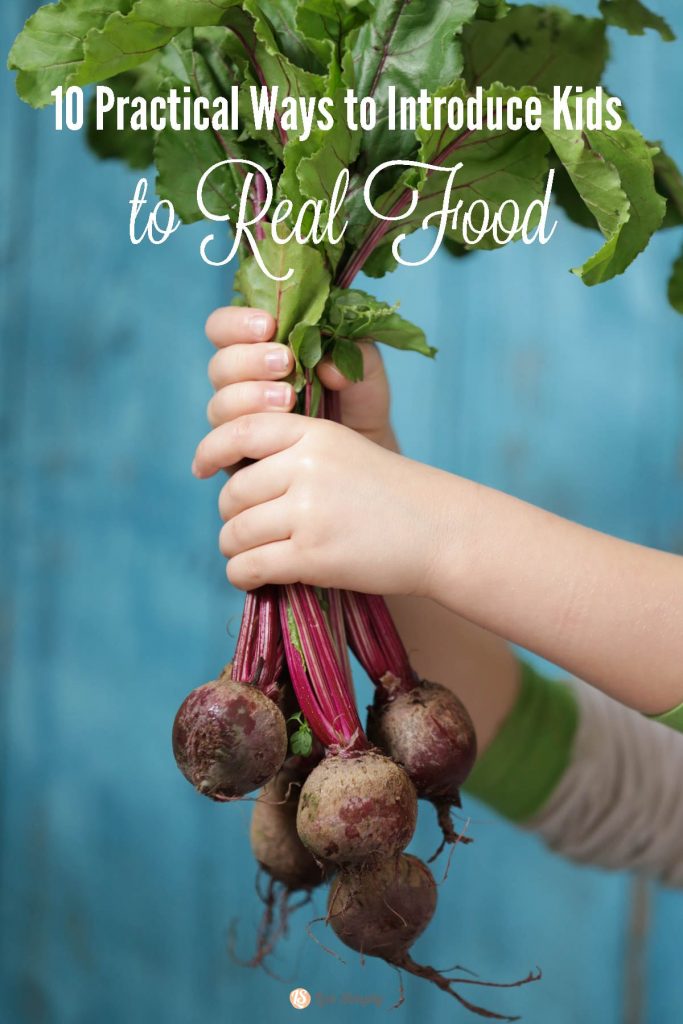If you’ve been around Live Simply for long, you may picture my family, based on my posts and recipes, at the dinner table each night munching away on grass-fed steak, roasted veggies, a big spinach salad with homemade dressing, and homemade herb bread. My children happily requesting extra veggies and loads of spinach salad with big smiles. You may think serving real food has been an easy task and wonder what kind of advice I would have for parents living in the real world of processed foods, grandparents, and play dates.
As I sat on the couch, writing this post, Dustin and Piper walked in the door, and guess what Piper was enjoying? A Chick-Fil-A cup filled to the brim with a cookies and cream milkshake. Dustin bought Piper a very rare, special treat.
Here is the definition of the word, “treat“: An event or item that is out of the ordinary and gives great pleasure.
That is exactly what that milkshake was–a treat!
While I strive to nourish my children with real, traditional foods on a daily basis, I’m well aware of reality. Drive-thru windows, grocery store shelves that use direct marketing to target children, birthday parties, and a husband and grandparents who enjoy offering commercial ice cream treats. I would love to write a post telling you that it’s easy to get children in America to eat real food, declaring that my children turn up their noses at the first sight of refined-sugar treats and artificial dyes. If offered, my kids would gladly indulge in such “food”.
If you are now feeling a tad bit discouraged, don’t be.
Our children enjoy real food around 85% -90% of the time. Feeding my children real nourishing food takes effort, commitment, and time.
Today, my children, ages two and four, regularly consume leafy greens and other veggies, fruit, whole grains, pastured meats, pastured eggs, nuts and seeds, bone broths, and healthy fats (real pastured butter and coconut oil).
10 Practical Ways to Introduce kids to Real Food
1. Start early. If you’re a new mom with a precious new baby or young toddler, say no to the food marketed to young babies and children. Introduce real food from the start. Children do not need separate meals, rather can enjoy the same real food as the rest of the family. By sharing in family meals, children learn at a young age to enjoy the diverse tastes and textures of real food.
2. Clean out. Clean out your pantry, fridge, secret box under the bed. Replace items like frozen chicken nuggets with homemade nuggets, here is a great recipe our family enjoys. Make homemade french fries. Stock your counter with homemade muffins and the freezer with homemade cookie dough for a special treat.
3. Be a team player. This means everyone in the family needs to make a commitment to eat real food. Talk with grandma and grandpa, daycare, a teacher. This doesn’t mean you can’t enjoy an occasional treat at grandma’s house, however, it will be just that– a treat.
4. Teach by example. Children will only embrace real food if parents do the same; modeling by example.
5. Slow down. In order to make real food a priority, it may be time to slow down so you have a couple more hours a week to prepare and enjoy real food. Children need to learn that real food doesn’t come from the shelf of a store, a package, or a drive-thru window, but rather is something that takes time to plan, prepare, and enjoy.
6. Be creative. Piper doesn’t care for leafy green veggies right now. I serve greens to him, but he usually doesn’t eat them. I ensure he is getting leafy greens in other ways, such as smoothies, or kale chips crushed in homemade popcorn. Even when “hiding food,” Dustin and I always explain the vegetables used to make a meal. I want him to have the knowledge and experience of eating vegetables.
7. Be honest. Teach your kids what real food is and is not. Talk about where real food comes from, how it is grown/raised, how it nourishes our body. With the knowledge of how food affects the body, kids can make better food choices.
8. Make food enjoyable. I believe food is meant to be enjoyed. There are times Piper, our pickiest eater, will refuse one of the choices we’re having for dinner. Since I am serving nourishing real food at breakfast, lunch, dinner, and snack, his body has been nourished with good food. I want him to form his own opinions on what he enjoys. While I consistently offer family meals, I don’t push.
9. Be prepared and consistent. If you wait until your kids are hungry and begging to eat, real food probably won’t happen. Be prepared to nourish your family by having a meal plan for the week. Plan out breakfast, lunch, dinner, and snacks. I find Sunday afternoon is a great time to spend a few extra hours in the kitchen preparing food for the week.
10. Encourage participation. Grow a garden together or at least a couple veggies or herbs in pots. Source local you-pick farms for fruit and/or veggies (check out localharvest.org for more info). Prepare meals together. Even a small child can help wash items or chop veggies (check out these real cutting knives for small hands) or mix ingredients in a bowl. Participation fosters a sense of ownership and pride.
Recommended Real Food Resource Books:
French Kids Eat Everything //Real Food for Mother and Baby // The Nourishing Traditions Book of Baby and Child Care // Real Food Planning Challenge




I discovered your blog tonight and am really enjoying your suggestions on eating more real food. I have a 3 year old and a 1 year old. I strive to feed all of us healthy, real foods but sometimes it us just easier to have a few processed items on hand. But, thinking more about the food scientist ingredients and whether my great-grandmother would have eaten this food is a good reminder to consider whether this is quality food for my family. I will keep reading – thanks!
This is so encouraging … Thanks so much for sharing ..:)
Yay…keep it coming.